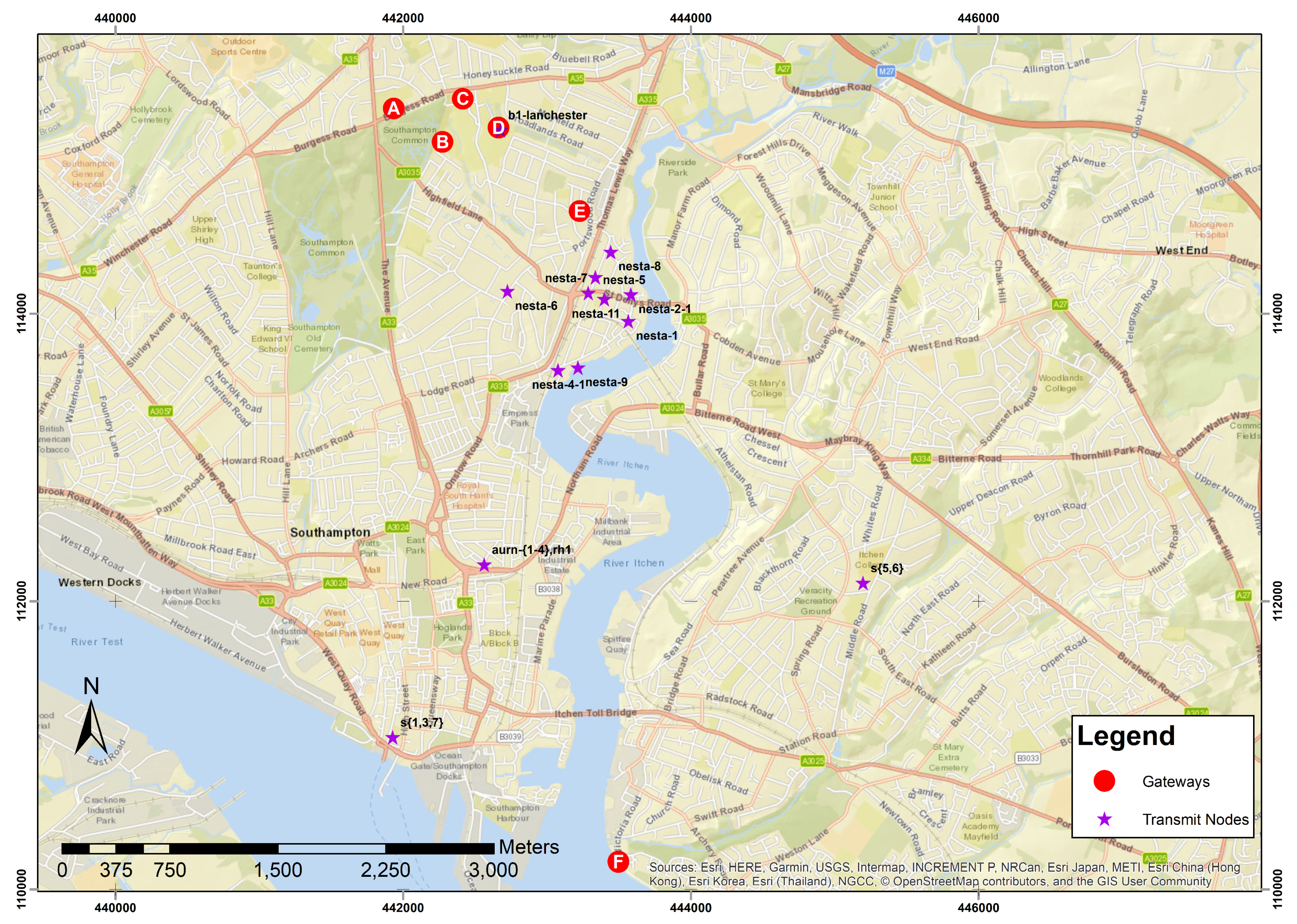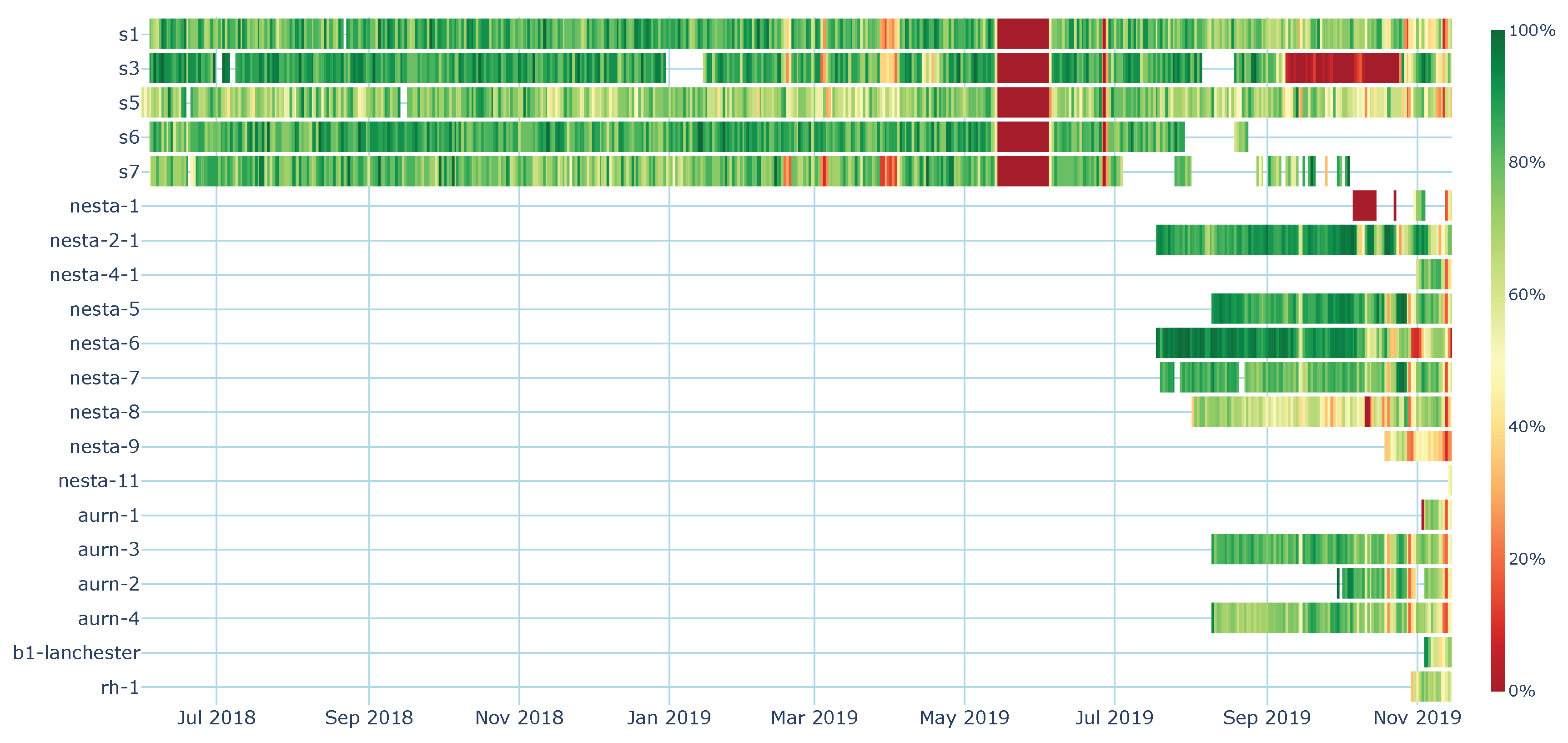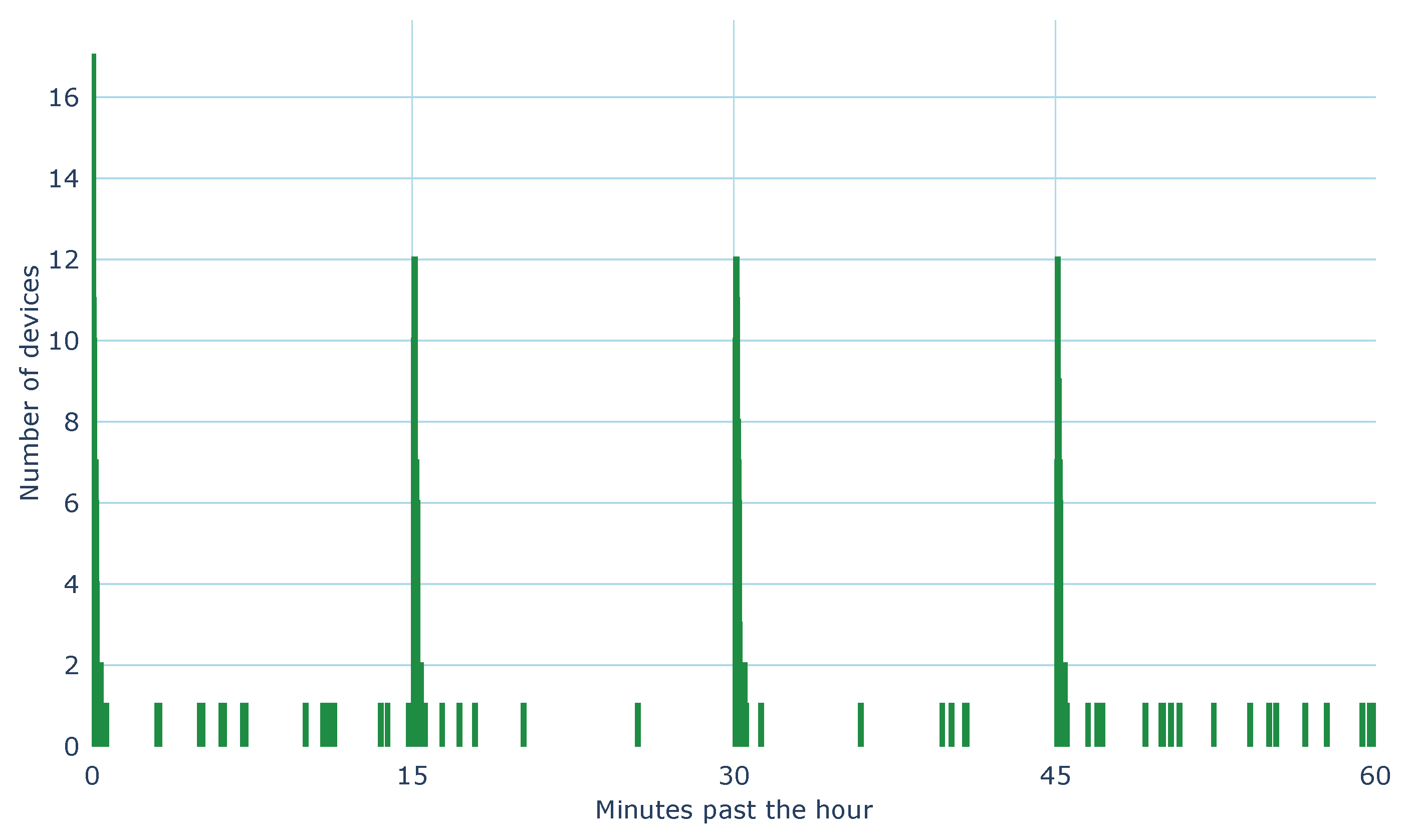LoRaWAN for Smart City IoT Deployments: A Long Term Evaluation
Abstract
1. Introduction
1.1. Low-Power Wide Area Network (LPWAN)
LoRaWAN
1.2. LoRa and LoRaWAN Test Beds
2. Southampton City LoRaWAN Deployment
2.1. Hardware
2.1.1. End Nodes
2.1.2. Gateways
2.2. Device Locations
3. LoRaWAN Message Analysis
3.1. Message Delivery Reliability
3.2. Message Delivery Delay
3.3. Message Scheduling
3.4. Atmospheric Influence on Message Delivery
4. Conclusions and Future Work
Author Contributions
Funding
Acknowledgments
Conflicts of Interest
References
- Bertolaud, A.; Delclef, J.; Delport, V.; Duffy, P.; Dyduch, F.; Eirich, T.; Ferreira, L.; Gharout, S.; Hersent, O.; Kasttet, A.; et al. LoRaWAN 1.1 Specification; Technical Report 1.1; LoRa Alliance: San Antonio, TX, USA, 2017. [Google Scholar]
- Zuniga, J.C.; Ponsard, B. Sigfox System Description. Available online: https://www.ietf.org/proceedings/97/slides/slides-97-lpwan-25-sigfox-system-description-00.pdf (accessed on 21 January 2020).
- Ratasuk, R.; Vejlgaard, B.; Mangalvedhe, N.; Ghosh, A. NB-IoT system for M2M communication. In Proceedings of the 2016 IEEE Wireless Communications and Networking Conference Workshops, WCNCW 2016, Doha, Qatar, 3–6 April 2016; pp. 428–432. [Google Scholar] [CrossRef]
- Johnston, S.J.; Basford, P.J.; Bulot, F.M.J.; Apetroaie-Cristea, M.; Cox, S.J.; Loxham, M.; Foster, G.L. IoT deployment for city scale air quality monitoring with Low Power Wide Area Networks. In Proceedings of the Global IoT Summit 2018, Bilbao, Spain, 4–7 June 2018. [Google Scholar] [CrossRef]
- Johnston, S.; Basford, P.; Bulot, F.; Apetroaie-Cristea, M.; Easton, N.; Davenport, C.; Foster, G.; Loxham, M.; Morris, A.; Cox, S. City Scale Particulate Matter Monitoring Using LoRaWAN Based Air Quality IoT Devices. Sensors 2019, 19, 209. [Google Scholar] [CrossRef] [PubMed]
- Bulot, F.M.J.; Johnston, S.J.; Basford, P.J.; Easton, N.H.C.; Apetroaie-Cristea, M.; Foster, G.L.; Morris, A.K.R.; Cox, S.J.; Loxham, M. Long-term field comparison of multiple low-cost particulate matter sensors in an outdoor urban environment. Sci. Rep. 2019, 9, 7497. [Google Scholar] [CrossRef] [PubMed]
- Basford, P.J.; Johnston, S.; Apetroaie-Cristea, M.; Bulot, F.; Cox, S. LoRaWAN for City Scale IoT Deployments. In Proceedings of the Global IoT Summit, Aarhus, Denmark, 17–21 June 2019. [Google Scholar] [CrossRef]
- Bardyn, J.P.; Melly, T.; Seller, O.; Sornin, N. IoT: The era of LPWAN is starting now. ICT Express 2019, 5, 1–7. [Google Scholar] [CrossRef]
- Haartsen, J.C. Bluetooth Radio System. In Wiley Encyclopedia of Telecommunications; John Wiley & Sons, Inc.: Hoboken, NJ, USA, 2003. [Google Scholar] [CrossRef]
- Crow, B.; Widjaja, I.; Kim, J.; Sakai, P. IEEE 802.11 Wireless Local Area Networks. IEEE Commun. Mag. 1997, 35, 116–126. [Google Scholar] [CrossRef]
- Farahani, S. ZigBee Wireless Networks and Transceivers; Elsevier Science & Technology Books: San Diego, CA, USA, 2008; p. 339. [Google Scholar]
- Mekki, K.; Bajic, E.; Chaxel, F.; Meyer, F. A comparative study of LPWAN technologies for large-scale IoT deployment. ICT Express 2018. [Google Scholar] [CrossRef]
- Yang, X.; Karampatzakis, E.; Doerr, C.; Kuipers, F. Security vulnerabilities in LoRaWAN. In Proceedings of the ACM/IEEE International Conference on Internet of Things Design and Implementation, IoTDI 2018, Orlando, FL, USA, 17–20 April 2018; pp. 129–140. [Google Scholar] [CrossRef]
- Butun, I.; Pereira, N.; Gidlund, M. Analysis of LoRaWAN v1.1 security. In Proceedings of the 4th ACM MobiHoc Workshop on Experiences with the Design and Implementation of Smart Objects— SMARTOBJECTS ’18, Los Angeles, CA, USA, 25 June 2018; ACM Press: New York, NY, USA, 2018; pp. 1–6. [Google Scholar] [CrossRef]
- Guibene, W.; Nowack, J.; Chalikias, N.; Fitzgibbon, K.; Kelly, M.; Prendergast, D. Evaluation of LPWAN Technologies for Smart Cities: River Monitoring Use-Case. In Proceedings of the 2017 IEEE Wireless Communications and Networking Conference Workshops, WCNCW 2017, San Francisco, CA, USA, 19–22 March 2017; pp. 1–5. [Google Scholar] [CrossRef]
- Sigfox Adds a Basestation and Geolocation. Available online: https://www.electronicsweekly.com/news/products/sigfox-adds-basestation-geolocation-2018-10/ (accessed on 13 January 2020).
- The Things Network. Available online: https://www.thethingsnetwork.org/ (accessed on 13 January 2020).
- Giezeman, W. Building a Crowdsourced Global IoT Network Operator. IEEE Int. Things Newsl. 2016. [Google Scholar]
- Coppen, R.; Banks, A.; Briggs, E.; Borgendale, K.; Gupta, R. MQTT Version 5.0. Available online: https://docs.oasis-open.org/mqtt/mqtt/v5.0/os/mqtt-v5.0-os.html (accessed on 13 January 2020).
- Lacuna Space. Available online: http://lacuna.space (accessed on 13 January 2020).
- Liu, H.; Darabi, H.; Banerjee, P.; Liu, J. Survey of wireless indoor positioning techniques and systems. IEEE Trans. Syst. Manand Cybern. Part C (Appl. Rev.) 2007, 37, 1067–1080. [Google Scholar] [CrossRef]
- Semtec. LoRa Cloud. Available online: https://www.loracloud.com/ (accessed on 13 January 2020).
- LoRa Alliance. LoRaWAN Geolocation Whitepaper. Available online: https://docs.wixstatic.com/ugd/eccc1a_d43b3b29dfff4ec2b00f349ced4225c4.pdf (accessed on 13 January 2020).
- Fargas, B.C.; Petersen, M.N. GPS-free geolocation using LoRa in low-power WANs. In Proceedings of the Global Internet of Things Summit (GIoTS), Geneva, Switzerland, 6–9 June 2017; pp. 1–6. [Google Scholar] [CrossRef]
- Cheong, P.S.; Bergs, J.; Hawinkel, C.; Famaey, J. Comparison of LoRaWAN classes and their power consumption. In Proceedings of the 2017 IEEE Symposium on Communications and Vehicular Technology (SCVT 2017), Leuven, Belgium, 14 November 2017. [Google Scholar] [CrossRef]
- The Things Industries. The Things Stack for LoRaWAN V3. Available online: https://github.com/TheThingsNetwork/lorawan-stack/ (accessed on 13 January 2020).
- Tzortzakis, K.; Papafotis, K.; Sotiriadis, P.P. Wireless self powered environmental monitoring system for smart cities based on LoRa. In Proceedings of the 4th Panhellenic Conference on Electronics and Telecommunications (PACET 2017), Xanthi, Greece, 17–18 November 2017; pp. 1–4. [Google Scholar] [CrossRef]
- Lee, H.C.; Ke, K.H. Monitoring of Large-Area IoT Sensors Using a LoRa Wireless Mesh Network System: Design and Evaluation. IEEE Trans. Instrum. Meas. 2018, 67, 2177–2187. [Google Scholar] [CrossRef]
- Pasolini, G.; Buratti, C.; Feltrin, L.; Zabini, F.; De Castro, C.; Verdone, R.; Andrisano, O. Smart City Pilot Projects Using LoRa and IEEE802.15.4 Technologies. Sensors 2018, 18, 1118. [Google Scholar] [CrossRef] [PubMed]
- Pasolini, G.; Buratti, C.; Feltrin, L.; Zabini, F.; Verdone, R.; Andrisano, O.; De Castro, C. Smart city pilot project using LoRa. In Proceedings of the 24th European Wireless 2018 “Wireless Futures in the Era of Network Programmability”, Catania, Italy, 2–4 May 2018; pp. 62–67. [Google Scholar]
- Petäjäjärvi, J.; Mikhaylov, K.; Roivainen, A.; Hänninen, T.; Pettissalo, M. On the coverage of LPWANs: Range evaluation and channel attenuation model for LoRa technology. In Proceedings of the 2015 14th International Conference on ITS Telecommunications (ITST), Copenhagen, Denmark, 2–4 December 2015; pp. 55–59. [Google Scholar] [CrossRef]
- Loriot, M.; Aljer, A.; Shahrour, I. Analysis of the use of lorawan technology in a large-scale smart city demonstrator. In Proceedings of the 2017 Sensors Networks Smart and Emerging Technologies (SENSET), Beirut, Lebanon, 12–14 September 2017; pp. 1–4. [Google Scholar] [CrossRef]
- Kulkarni, P.; Hakim, Q.A.; Lakas, A. Experimental Evaluation of a Campus-deployed IoT Network using LoRa. IEEE Sens. J. 2019. [Google Scholar] [CrossRef]
- Doğan, G. Empirical Observations on LoRa Performance for Different Environments. In Proceedings of the 2019 International Conference on Applied Automation and Industrial Diagnostics (ICAAID), Elazig, Turkey, 25–27 September 2019; pp. 1–6. [Google Scholar] [CrossRef]
- Marais, J.M. Construction and performance evaluation of a LoRaWAN testbed. Master’s Thesis, University of Pretoria, Pretoria, South Africa, 2018. [Google Scholar]
- Marais, J.M.; Malekian, R.; Abu-Mahfouz, A.M. Evaluating the LoRaWAN Protocol Using a Permanent Outdoor Testbed. IEEE Sens. J. 2019, 19, 4726–4733. [Google Scholar] [CrossRef]
- Wixted, A.J.; Kinnaird, P.; Larijani, H.; Tait, A.; Ahmadinia, A.; Strachan, N. Evaluation of LoRa and LoRaWAN for wireless sensor networks. Proc. IEEE Sens. 2017, 0, 5–7. [Google Scholar] [CrossRef]
- Fernandes Carvalho, D.; Depari, A.; Ferrari, P.; Flammini, A.; Rinaldi, S.; Sisinni, E. On the evaluation of application level delays in public LoRaWAN networks. In Proceedings of the 2019 IEEE International Symposium on Measurements and Networking, Catania, Italy, 8–10 July 2019; pp. 1–6. [Google Scholar] [CrossRef]
- Pötsch, A.; Hammer, F. Towards End-to-End Latency of LoRaWAN: Experimental Analysis and IIoT Applicability. In Proceedings of the 2019 IEEE International Symposium on Measurements and Networking, Sundsvall, Sweden, 27–29 May 2019. [Google Scholar] [CrossRef]
- Estimates of the Population for the UK, England and Wales, Scotland and Northern Ireland—Office for National Statistics. Available online: https://www.ons.gov.uk/peoplepopulationandcommunity/populationandmigration/populationestimates/datasets/populationestimatesforukenglandandwalesscotlandandnorthernireland (accessed on 22 January 2020).
- Landrigan, P.J.; Fuller, R.; Acosta, N.J.; Adeyi, O.; Arnold, R.; Basu, N.; Baldé, A.B.; Bertollini, R.; Bose-O’Reilly, S.; Boufford, J.I.; et al. The Lancet Commission on pollution and health. Lancet 2018, 391, 462–512. [Google Scholar] [CrossRef]
- Williams, M.; Evangelopoulos, D.; Katsouyanni, K.; Walton, H. Personalising the Health Impacts of Air Pollution: Summary for Decision Makers; Technical Report; Environmental Research Group King’s College London: London, UK, 2019. [Google Scholar]
- Elsys.se. ESM5k LoRaWAN Wireless Sensor. Available online: https://elsys.se/public/datasheets/ESM5k-folder.pdf (accessed on 13 January 2020).
- Harris, N.R.; Curry, J.S. Development and Range Testing of a LoRaWAN System in an Urban Environment. Int. J. Electron. Commun. Eng. 2018, 12, 47–55. [Google Scholar] [CrossRef]
- Basford, P.J.; Johnston, S.J.; Cox, S.J. computenodes/pi-cot: Pi Concentrator on Top V2.0.1 release | Zenodo. Available online: https://doi.org/10.5281/zenodo.2539362 (accessed on 22 January 2020).
- Meijers, J. TTNMapper. Available online: https://ttnmapper.org/ (accessed on 13 January 2020).
- Martinez, I.; Tanguy, P.; Nouvel, F. On the performance evaluation of LoRaWAN under Jamming. In Proceedings of the 2019 12th IFIP Wireless and Mobile Networking Conference (WMNC), Paris, France, 11–13 September 2019; pp. 141–145. [Google Scholar] [CrossRef]
- Gu, C.; Tan, R.; Huang, J. Secure Data Timestamping in Synchronization-Free LoRaWAN. arXiv 2019, arXiv:1905.01679. [Google Scholar]
- Varsier, N.; Schwoerer, J. Capacity limits of LoRaWAN technology for smart metering applications. In Proceedings of the 2017 IEEE International Conference on Communications (ICC), Paris, France, 21–25 May 2017; pp. 1–6. [Google Scholar] [CrossRef]
- Rahmadhani, A.; Kuipers, F. When LoRaWAN Frames Collide. In Proceedings of the 12th International Workshop on Wireless Network Testbeds, Experimental Evaluation and Characterization, New Delhi, India, 2 October 2018; pp. 89–97. [Google Scholar]
- Bezerra, N.S.; Åhlund, C.; Saguna, S.; de Sousa, V.A., Jr. Temperature Impact in LoRaWAN—A Case Study in Northern Sweden. Sensors 2019, 19, 4414. [Google Scholar] [CrossRef] [PubMed]
- Barro, P.A.; Zennaro, M.; Degila, J.; Pietrosemoli, E. A smart cities LoRaWAN network based on autonomous base stations (BS) for some countries with limited internet access. Future Internet 2019, 11, 93. [Google Scholar] [CrossRef]
- Vangelista, L.; Centenaro, M. Worldwide connectivity for the internet of things through LoRaWAN. Future Internet 2019, 11, 57. [Google Scholar] [CrossRef]
- pyonair/PyonAir-pycom 0.2.6 | Zenodo. Available online: https://doi.org/10.5281/ZENODO.3434214 (accessed on 22 January 2020).
- pyonair/PyonAir-PCB: PyonAir 2019 v5.0 | Zenodo. Available online: https://doi.org/10.5281/ZENODO.3414843 (accessed on 22 January 2020).



| LoRaWAN | Sigfox | NB-IoT | |
|---|---|---|---|
| Frequency bands | Unlicensed | Unlicensed | Licensed |
| Range (urban) | 5 | 10 | 1 |
| Range (rural) | 20 | 40 | 10 |
| Maximum data rate | 50 bit/ | bit/ | 200 bit/ |
| Maximum messages per day | Unlimited | 140 Up, 4 Down | Unlimited |
| Modulation | CSS | BPSK | QPSK |
| Encryption | Yes | No | Yes |
| Adaptive Data Rate (ADR) | Yes | No | No |
| Private networks | Yes | No | No |
| Gateways locations determined by | Anyone | Operator | Operator |
| Localisation | RSSI & TDOA | RSSI | No |
| Raspberry Pi & LoRa HAT | Siconia | Pytrack & LoPy | Raspberry Pi & LoRa Node pHAT | ESM5k | |
|---|---|---|---|---|---|
| Manufacturer | Raspberry Pi & Seeed Studio | Sagemcom | Pycom | Raspberry Pi & Pi Supply | Elsys.se |
| LoRa hardware | Dragino LoRa | Proprietary | Proprietary | pHAT | Proprietary |
| Order of power usage | |||||
| Built in GPS | Yes | No | Yes | No | No |
| Customisability | High | None | Medium | High | None |
| Battery Included | No | Yes | No | No | Yes |
| Programming Language(s) | Various | JavaScript | MicroPython | Various | None |
| Enclosure type | None | Waterproof | None | None | Indoor |
| Multi-region support | No | No | Yes | Yes | No |
| Cost (USD) | 90 | 40 | 120 | 90 | 100 |
| Dragino Single Channel-Gateway | IMST iC880A | IoT LoRa Gateway HAT | |
|---|---|---|---|
| LoRa manufacturer | Dragino | IMST | Pi Supply |
| Simultaneous channels | 1 | 8 | 8 |
| Price (USD) | 100 | 250 | 250 |
| Deployment scale | Desk | Campus | Campus |
| Uplink | WiFi/Ethernet | WiFi/Ethernet | WiFi/Ethernet |
| Accurate time stamp | No | No | No |
| Onboard GPS | Yes | No | No |
| Waterproof enclosure | No | No | No |
| Direct connection to Raspberry Pi | Yes | No | Yes |
| The Things Indoor Gateway | The Things Gateway | The Things Outdoor Gateway | Kerlink iBST | |
|---|---|---|---|---|
| Simultaneous channels | 8 | 8 | ||
| Price (USD) | 80 | 380 | 520 | 2500 |
| Deployment scale | House | Campus | County | County |
| Uplink | WiFi | WiFi/Ethernet | Ethernet/GPRS | Ethernet/GPRS |
| Accurate time stamp | No | No | No | Yes |
| Onboard GPS | No | No | Yes | Yes |
| Waterproof enclosure | No | No | Yes | Yes |
| Location | Altitude (m) | Gateway | Antenna | Third Party |
|---|---|---|---|---|
| A | 85 | Kerlink iBTS | Procom CXL 900-3LW/I | No |
| A | 85 | IMST iC880A | Procom CXL 900-3LW-NB | No |
| B | 45 | Kerlink iBTS | Procom CXL 900-3LW/I & Procom CXL 900-3LW-NB | No |
| C | 60 | IMST iC880A | RF Solutions FLEXI-SMA90-868 | Yes |
| D | 50 | Kerlink iBTS | Procom CXL 900-3LW/I & Procom CXL 900-3LW-NB | No |
| D | 45 | IMST iC880A | Taoglas OMB | No |
| E | 20 | The Things Indoor gateway | Internal | No |
| E | 25 | IMST iC880A | CMPLR-ANT415EU | No |
| F | 8 | Kerlink iBTS | Procom CXL 900-3LW-NB (Dual) | No |
| Time after Transmission (s) | Percentage of Successful Messages Received |
|---|---|
| 1 | 21 |
| 6 | 95 |
| 10 | 99 |
| 14 | 99.9 |
© 2020 by the authors. Licensee MDPI, Basel, Switzerland. This article is an open access article distributed under the terms and conditions of the Creative Commons Attribution (CC BY) license (http://creativecommons.org/licenses/by/4.0/).
Share and Cite
Basford, P.J.; Bulot, F.M.J.; Apetroaie-Cristea, M.; Cox, S.J.; Ossont, S.J. LoRaWAN for Smart City IoT Deployments: A Long Term Evaluation. Sensors 2020, 20, 648. https://doi.org/10.3390/s20030648
Basford PJ, Bulot FMJ, Apetroaie-Cristea M, Cox SJ, Ossont SJ. LoRaWAN for Smart City IoT Deployments: A Long Term Evaluation. Sensors. 2020; 20(3):648. https://doi.org/10.3390/s20030648
Chicago/Turabian StyleBasford, Philip J., Florentin M. J. Bulot, Mihaela Apetroaie-Cristea, Simon J. Cox, and Steven J. Ossont. 2020. "LoRaWAN for Smart City IoT Deployments: A Long Term Evaluation" Sensors 20, no. 3: 648. https://doi.org/10.3390/s20030648
APA StyleBasford, P. J., Bulot, F. M. J., Apetroaie-Cristea, M., Cox, S. J., & Ossont, S. J. (2020). LoRaWAN for Smart City IoT Deployments: A Long Term Evaluation. Sensors, 20(3), 648. https://doi.org/10.3390/s20030648






